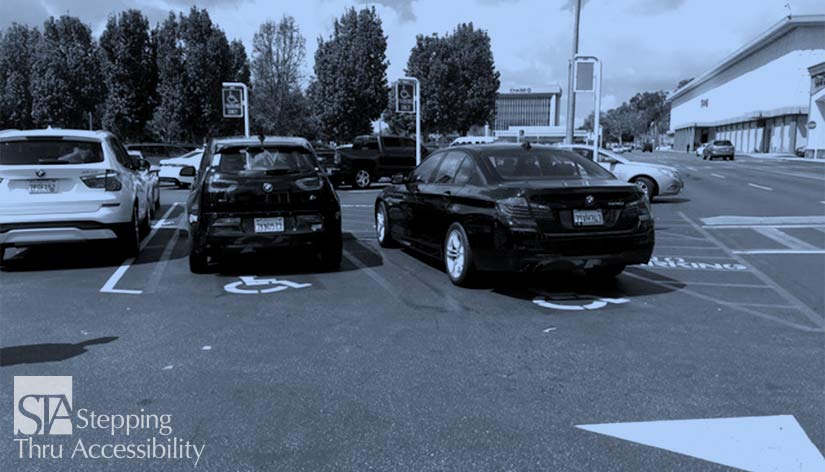Blog
Return to Blog »
Janis Kent, FAIA, Architect, CASp © February, 2022 The question comes up quite often of what minimally is required to be done for alterations on parking. And for that matter, what about barrier removal when no alterations are happening. Are the requirements the same across the board for addressing non-compliant accessible parking spaces? And this does get confused since it requires looking closely at the wording of the implementing regulations. When we talk about alterations, what we are talking about is proportional spending on path of travel elements. And this is dependent upon construction costs as well as the prioritization of parking in the priority list. With a small construction budget, we may only address the first items on the list. But as construction costs increase all of the prioritized items supporting the altered space might need to be brought up to current standards if in non-compliance. DOJ states the following under § 36.403 Alterations: Path of Travel (g) Duty to provide accessible features in the event of disproportionality. (1) When the cost of alterations necessary to make the path of travel to the altered area fully accessible is disproportionate to the cost of the overall alteration, the path of travel shall be made accessible to the extent that it can be made accessible without incurring disproportionate costs. (2) In choosing which accessible elements to provide, priority should be given to those elements that will provide the greatest access, in the following order: (i) An accessible entrance; (ii) An accessible route to the altered area; (iii) At least one accessible restroom for each sex or a single unisex restroom; (iv) Accessible telephones; (v) Accessible drinking fountains; and (vi) When possible, additional accessible elements such as parking, storage, and alarms. Notice that parking is listed in the 6th priority. But also notice the second priority – An accessible route to the altered area. How does that impact parking, you might ask. Under § 36.403 Alterations: Path of Travel, DOJ defines path of travel as: (e) Path of travel. (2) An accessible path of travel may consist of walks and sidewalks, curb ramps and other interior or exterior pedestrian ramps; clear floor paths through lobbies, corridors, rooms, and other improved areas; parking access aisles; elevators and lifts; or a combination of these elements. So for alterations, and priorities under proportional spending, parking is the 6th priority level whereas parking access aisles are in the second priority. Be aware that this latter does not include the parking space but rather just the access aisle. Related Ebook: Access and Vehicles Under Title II of the ADA, § 35.151 New Construction and Alterations, (b) (4) (ii) (A), an access aisle is defined as part of the path of travel similar to Title III entities. And in the event of disproportionality under § 35.151 (b) (4) (iv) (B), priorities are also the same as under Title III entities. But note, disproportionality under Title II is only allowed in alterations that have nothing to do with meeting program accessibility requirements. Under Title III, barrier removal, providing accessible parking is first out of four items under priorities for places of public accommodation. DOJ states the following under § 36.304 Removal of barriers; (c) Priorities. A public accommodation is urged to take measures to comply with the barrier removal requirements of this section in accordance with the following order of priorities. (1) First, a public accommodation should take measures to provide access to a place of public accommodation from public sidewalks, parking, or public transportation. These measures include, for example, installing an entrance ramp, widening entrances, and providing accessible parking spaces…. But note, barrier removal is a Title III term, not Title II which has program accessibility with differing requirements. In summary for alterations, in terms of disproportionality, note that DOJ considers the accessible route/path of travel the second priority after entrances and they also consider and define the parking access aisle as part of the accessible path of travel. For public entities under Title II, item A, listed above is not applicable. Items B and C are only applicable if the alteration has nothing to do with program accessibility. For places of public accommodation under Title III, A, B, and C are all applicable. So, if one is performing an alteration, providing an accessible access aisle is the 2nd priority and providing accessible parking is the 6th priority for both a place of public accommodation and a public facility, as long as for the latter, the alteration is not for program accessibility. And parking is in the first priority for barrier removal. Lots of terminology here, but one does need to understand disproportionality, alterations vs barrier removal, program accessibility, path of travel requirements, and the differences between Title II and Title III entities in order to understand when to apply what. One little note – under CBC Section 11B-202.4, parking is not listed as one of the elements under the primary accessible path of travel. But under ADA, parking access aisles are defined as part of the accessible route, and accessible parking is listed as a priority for path of travel. So parking is considered part of the path of travel under ADA and this would take precedence over local codes Be aware that your local City or County may have additional requirements that are more restrictive than the State or Federal requirements. Also, this article is an interpretation and opinion of the writer. It is meant as a summary – current original regulations should always be reviewed when making any decisions. © Janis Kent, FAIA, Architect, CASp 2022Parking Priority in Alterations and Barrier Removal

Alterations – Title III for Places of Public Accommodation
Alterations – Title II for Public State and Local Government Facilities
Barrier Removal
Summary